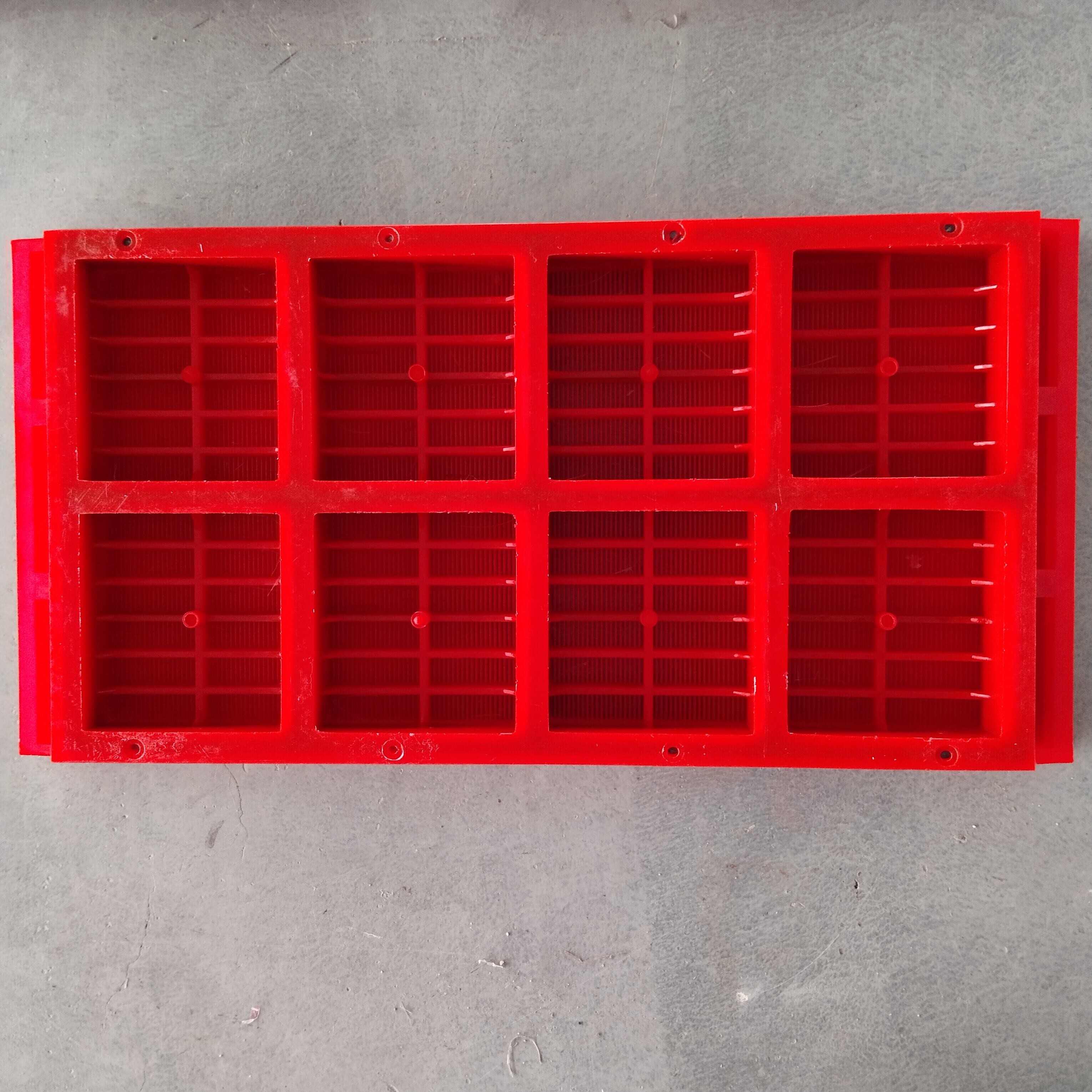Key Properties of Polyurethane Screen Media Affecting Product Quality
Wear Resistance and Longevity in Demanding Applications
Screen media made from polyurethane stands out because they just don't wear down as fast as other options. According to various field tests, these screens tend to last around 7 to 9 times longer than regular metal or synthetic alternatives. That means fewer replacements needed and less time spent fixing things when operations get busy. The material handles all sorts of rough treatment too. Mining crews know this well since their equipment gets battered daily with rocks and debris. Construction sites face similar challenges with constant vibration and abrasive materials passing through. When screens actually stay intact longer, it saves money in multiple ways. Not only do businesses avoid buying new screens so often, but they also cut back on lost productivity during installation periods. Some companies report saving thousands annually simply by switching to polyurethane screens.
Tapered Openings: Reducing Blinding for Consistent Output
The tapered openings on polyurethane screens are pretty much what makes them so effective at fighting against blinding issues. When materials pass through these screens, the special shape stops small particles from getting stuck and blocking the surface. This means the material keeps flowing smoothly without interruptions, giving manufacturers a more predictable output rate. For companies running processing lines day after day, this kind of reliability matters a lot. Some actual field tests have shown that when plants switch to these tapered designs, they see noticeable drops in downtime caused by blocked screens. The result? Less wasted time fixing problems and more products moving through the system efficiently.
Elastic Memory: Maintaining Opening Integrity Under Stress
Polyurethane screen media bounce back pretty well after getting squished, returning to their original shape and keeping those openings intact even when deformed. This elasticity really matters for maintaining good screening results when things get rough during operation, which helps these screens last longer and work better. From what we've seen in actual plant operations, screens that retain their shape tend to break down less often and keep performing consistently month after month. The ability to stay true to form means they separate materials properly most of the time, which translates into better production numbers and more consistent product quality across the board.
Comparative Performance Against Traditional Screening Materials
Polyurethane vs Woven Wire: 7-9x Longer Service Life
When it comes to how long they last, polyurethane screens beat woven wire versions by a huge margin, often lasting around nine times as long before needing replacement. What really matters though isn't just the technical specs but what this means for actual businesses. Companies save serious money when they switch because they don't have to keep buying new screens so frequently. Some factories reported cutting replacement costs by over 70% after making the change. Real world tests across different industries back this up too. Not only do companies save cash, but workers spend less time dealing with maintenance issues since the polyurethane lasts so much longer between replacements. For plant managers watching both their budgets and production schedules, this kind of reliability makes all the difference.
Noise Reduction Advantages Over Metal Screen Surfaces
Polyurethane materials stand out because they really cut down on noise, which makes them better than old fashioned metal screens in many cases. For factories and plants dealing with loud machinery, getting rid of excess noise matters a lot. When businesses follow local noise laws, they stay on the right side of regulations while creating workplaces that aren't so grating on the ears. Some studies point to actual results too. Plants that switched to polyurethane screen media report way fewer complaints from nearby neighborhoods about constant industrial noise. This isn't just theoretical stuff it works in practice across different manufacturing settings.
Moisture Resistance Compared to Polyester Filter Screens
When it comes to handling moisture, polyurethane screens really stand out compared to their polyester counterparts, especially when working in damp environments. These screens don't break down as easily when exposed to humidity, which means they last much longer than other materials on the market. Manufacturing plants have reported significant improvements after switching to polyurethane, with many noting dramatically reduced problems during rainy seasons or in coastal areas where humidity is always high. What makes this so valuable? Well, equipment that lasts longer means less downtime for maintenance and replacement parts. Companies across various sectors have found that investing in these moisture resistant screens pays off handsomely over time, both in terms of productivity and wallet health.
Operational Impacts on Production Quality Metrics
Throughput Enhancement Through Reduced Downtime
Using polyurethane screens boosts production throughput because they cut down on equipment downtime. These screens last longer and work consistently without breaking down, so factory operations don't get interrupted as often. That matters a lot when trying to keep production numbers high. Some studies show businesses that switch to these screens see their output go up around 20%. The real benefit goes beyond just making more products faster though. When machines run smoothly without constant stops, the whole workflow becomes more predictable and efficient, which helps companies perform better across all aspects of their operations.
Gradation Consistency in Aggregate Sizing
Keeping aggregate sizes consistent matters a lot for maintaining good quality during production runs. Polyurethane screens really help out here. These screens are built to cut down on size variations in materials, something that makes all the difference when it comes to passing quality checks. Looking at actual factory data, operations using polyurethane media tend to see better results across the board. One plant reported a 15% improvement in their grading accuracy after switching to these screens. The bottom line is that polyurethane helps manufacturers get those uniform products customers expect, without all the headaches from inconsistent sizing issues.
Contamination Reduction in Recycling Streams
The use of polyurethane screen media makes a real difference when it comes to cutting down on contamination during recycling operations. For businesses in sectors where product purity matters most, these screens have become essential tools for meeting regulations and keeping customers happy. According to various field tests and what we see across the industry, companies that switch to polyurethane tech generally find much less debris mixed into their finished products. Cleaner material streams mean higher quality recyclables overall. This not only helps facilities stay within legal limits but also supports broader green goals since purer materials can be reused more effectively without compromising performance standards.
Industry-Specific Quality Improvements
Mining: Preserving Particle Integrity in Mineral Processing
In mineral processing operations, polyurethane screens are essential for keeping particles intact, something that directly affects the final product quality. What makes these screens so valuable is their combination of toughness and bendability, which cuts down on unwanted breakage during processing. Particles stay true to their original specs even after going through tough handling stages. Mining firms across the country keep coming back to polyurethane because they see better results in their quality control metrics. The mining sector has really benefited from these resilient screens. They've made processing much more reliable over time, with fewer inconsistencies showing up in batches. This reliability translates to smoother operations day to day, saving money and headaches for plant managers dealing with production demands.
Construction: Maintaining ASTM Specification Compliance
Following ASTM specs matters a lot in construction work for safety reasons and making sure things are built right. Polyurethane screen media plays a big role here since they help contractors stay within those regulations when sorting materials on site. The screens give accurate results time after time, so construction teams can rest easier knowing their processes check out. When companies stick strictly to these standards, they protect themselves from potential problems down the road while building better relationships with customers who notice this attention to detail. According to recent industry reports, businesses that switch to polyurethane screening tend to have fewer compliance issues than others. This makes sense because happy clients want to work with partners they can trust, especially when it comes to something as critical as construction safety.
Waste Management: Improving Purity of Recycled Materials
In the world of waste management, polyurethane screens play a major role in making recycled materials cleaner and purer. These screens work really well at separating different types of waste, which means companies can produce better quality recyclables that actually meet what regulators require and what customers want. Looking at real world results, businesses that install these screens tend to recover significantly more usable materials from their waste streams. For instance, some recycling plants report getting an extra 15% clean plastic back after switching to polyurethane screening systems. When this happens, the stuff that goes back into manufacturing is just better overall. Cleaner materials mean fewer rejects during production runs, which saves money for manufacturers while also helping the environment because there's less need to process virgin materials.

